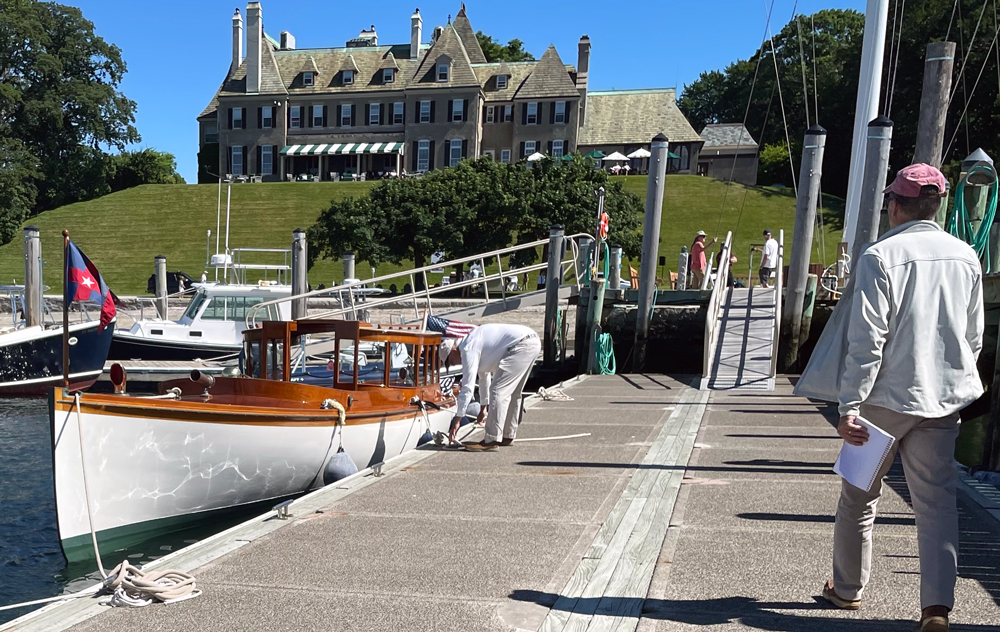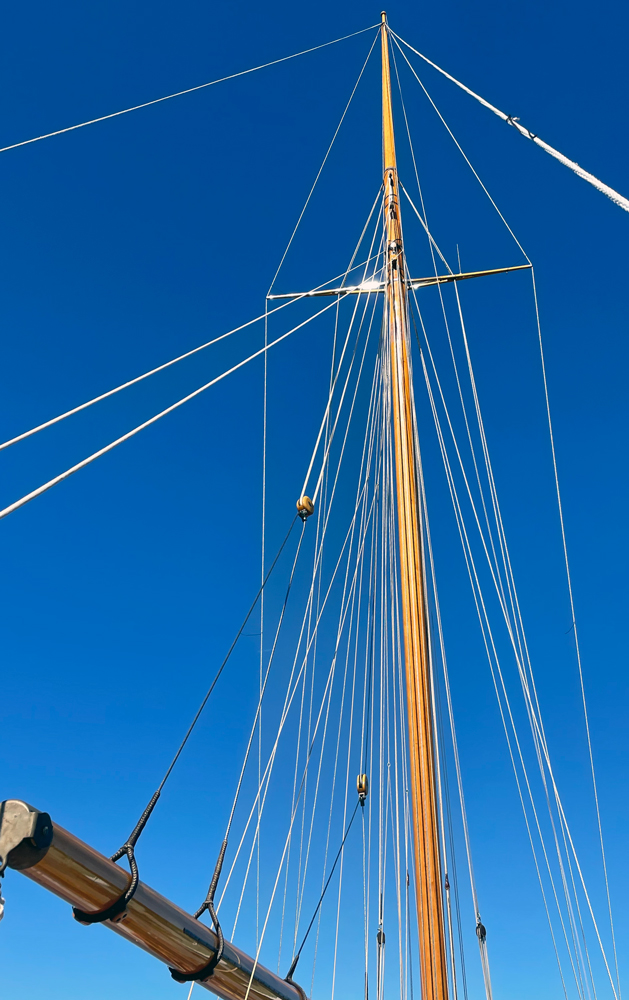A few weeks ago, I was lucky enough to attend an event celebrating the Herreshoff Marine Museum’s 50th birthday, which gathered three classic one design sailboats together at the New York Yacht Club dock. Though they all make even my Snipe looks quite modern by comparison, each one was originally built to solve exactly the same problem: create a boat to be raced against others so similar, there was no need for a rating rule. Somehow, the HMCo assembly line turned out one boat per week, though only a few are still sailing.
The organizers also invited a lovely little launch to crash the party.

I was included so I could do the homework for a Seahorse article. And even though it was a fantastically inspiring event and I recorded several interviews, on the drive home I found myself wondering: what should this article be about? There were too many obvious answers: the boats, of course; their owners; the museum’s unique history and newly refreshed energy. Already, that’s way too many life-stories to fit into a single piece—and I had plenty of other thoughts as well. I needed to find a framework that would help filter out what didn’t belong. (Oh, that lovely launch.)
Fortunately, I carry my most important tool with me at all times: curiosity. And what has continued to intrigue me about that evening and those boats is the ageless appeal of one-design racing—perhaps because I’m also working on another project that celebrates just that. I’m not yet sure exactly where this idea will lead, but I do trust that following my instincts will uncover a fresh story.

One design boats are no longer made of wood (and most take more than week to complete), but my varnish-free 21st century Snipe shares a timeless goal with these three turn-of-the-last-century beauties: to provide even racing for whomever shows up on the starting line. The first boat to finish wins the race. Such a simple goal; and yet for over a century, so many people have spent countless hours and dollars in their pursuit of it.
By the time you read this, I will (hopefully) have come up with a more concrete plan for the story. But just in case I’m still searching for ideas… let me know in the comments below or by email what your most burning question is about any of these three one designs (and, of course, that lovely launch). You can also find out more by visiting the Herreshoff Marine Museum. Thanks—and here’s to one design racing, in any century!
Carol,
Here’s my question: are there any ‘first principles’ or enduring design characteristics that are shared by the the three Woodies and our modern Snipe? I’m thinking, like relationship of overall length to width, or height of mast as a percentage of LOA….
In math and many other areas, we have PI as the ratio of circumference and diameter. The Golden Ratio comes to mind, as well.
Karen, thanks for the question. I will make sure to ask it of someone more math-oriented than me!
I hope to read your article. I would have loved to attend the 50th (I am a museum member) but just wasn’t to be. It is all about the boats for sure, but one thing I am very happy about: there are people in this world that care enough and have enough disposable resources to restore and care for these classics. It’s an interesting philosophical argument about whether during a complete refit – and I mean complete, often with only a small percentage of the original material left – the boats are really the “original”. After all, the documentation at MIT for the HMCo designs is so extensive it would not be difficult to build a brand new one, even following the original construction methods. After pondering this question and watching a number or refits (HMCo Doris at Snediker comes to mind), the way they are done is essentially 100 years of maintenance compressed into a few years. So yes, they are the original, only better to last another 100 years. I think it’s fantastic that so many of the NY 30s are still here given they were state of the art “lightweight” racing boats never with the intention to live so long. The larger they were the less well they fared over time as evidenced by the number of 30s, fewer 40s, one 50 and no 70s (known as “leakabouts” with “composite construction, wood over steel frames, something that was innovative but not successful).
As to Karen’s question above, that is quite subjective. NGH was a very intuitive designer and his design method using model carving and small scale “water testing” was done to his eye even while he had the the rule du jour in mind. Of course design of racing boats is ALWAYS driven by the rating rules as designers look to exploit them for gain even if they do end up being used to create a one design class. Various rules starting with the Seawanhaka rule (Reliance being the most extreme) through the International rule (the NY one designs, many HMco designs and all of the “meter” boats), the CCA designs and all the way through IOR favored (ever decreasingly) long overhangs that increased waterline length while sailing. To me, these were very aesthetically pleasing. After IOR, rules really changed so this fell out of favor and modern lightweight boats with plumb bows/sterns are en vogue. Are these more aesthetically pleasing? My guess is that discussion would be like religion, best enjoyed in private 😉
Alex,
Thanks for all this added context/info. I hadn’t thought about comparing the time it took to build a fleet of NY30s (six months) vs the ongoing “improvements” that Snipe builders are still making, 80-plus years and many technological innovations (fiberglass) later. Also, I agree with you that the restorations are still “original”… and I’m also very glad that there are people willing to invest so much time, money, and expertise into keeping these beauties going!
I love this approach, Carol, and I’m so glad you could join us! As Evelyn (Ansel, HMM Curator) mentioned in her remarks, the NY-30s (the first of the NYYC One-Designs) took a very prescriptive approach to the concept with a very tight set of rules around everything from the involvement of professionals to the silverware and plates that needed to be onboard while racing – which offers a compelling connection to today’s Melges IC37, the most recent incarnation of a NYYC one-design. Alex is right that NGH was an intuitive designer and that his process started with the carving of a half hull, but a careful study of his papers reveals a highly disciplined engineer using a high-level mathematical approach to every detail including calculations of everything from displacement to stress testing of various materials. Arguably, an incredibly unique combination of art and science!
Bill, thanks for the reminder about NGH’s engineering approach; an incredible combination of art and science indeed. Can’t wait to get started on this story! (Other more time-sensitive projects are currently demanding my attention…)
Bill, this “dual” aspect of NGH’s work has always fascinated me and something that has gotten me so interested in the Herreshoff history (in addition to growing up sailing in Marion and being around his designs). The combination of art and science has always produced stunning innovation in many different genres. Steve Jobs, while he was not an engineer himself, had a similar approach. In the same vein, all of the best sailors I know are able to span the gap between “the numbers” and “the feel”. BTW, one of the highlights of the last few years was the ability to take Mischief for a sail in Oyster Bay 🙂
Alex,
Agreed that the best sailors and designers are somewhere in the hazy middle of the vast spectrum between artist and scientist. I love the quote from Bruce Kirby that showed up in one of the tributes to him: “I had a copy of Skene’s Elements of Yacht Design. If you can understand 50% of what’s in that book, you can design a boat. Design isn’t brain surgery. We should always pretend that it is, but it’s really not.”